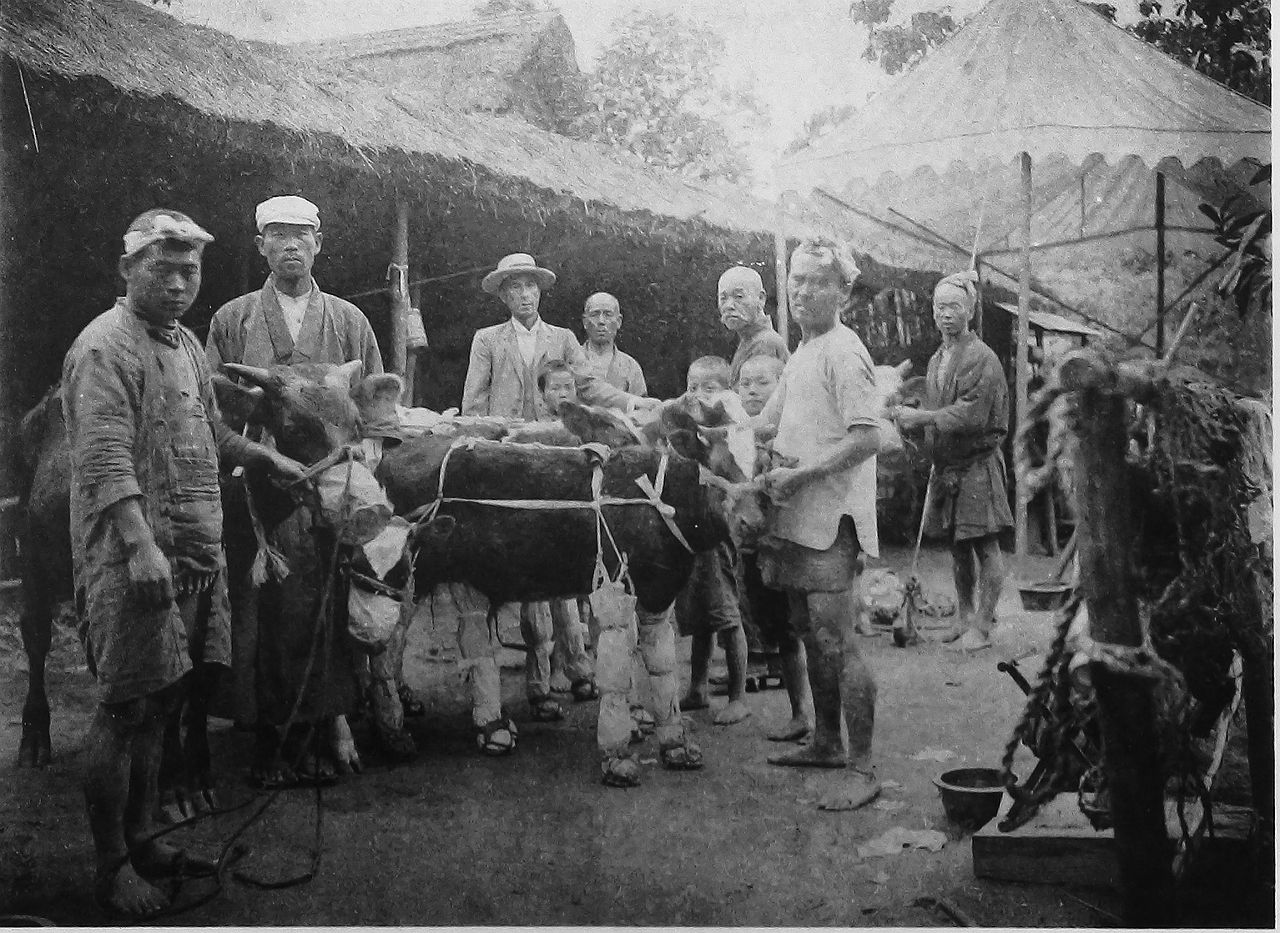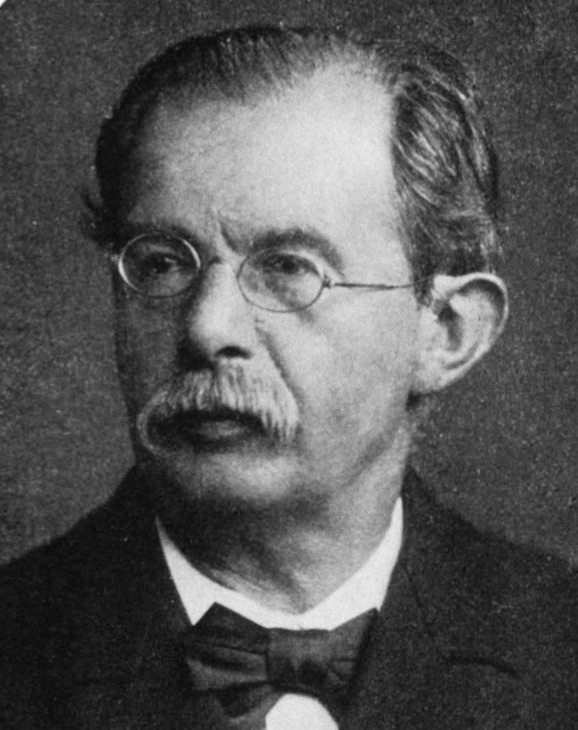藤浪 鑑
Akira FUJINAMI, 1871-1934

藤浪 鑑
Akira FUJINAMI, 1871-1934

★藤浪 鑑(ふじなみ あきら、1871年1月19日(明治3年11月29日) -
1934年(昭和9年)11月18日)は、日本の医師、病理学者。藤浪肉腫の発見者として知られる。
| 藤浪 鑑(ふじなみ あきら、1871年1月19日(明治3年11月29日) - 1934年(昭和9年)11月18日)は、日本の医師、病理学者。藤浪肉腫の発見者として知られる。 | |
 |
1870年(明治3年)旧尾張藩の侍医、藤浪萬得の長男 [1]
として愛知県名古屋市に生まれる。生家は代々の尾張藩医という名門であった。 1895年(明治28年)に東京帝国大学医科大学を首席卒業。病理学教室に入り、当時ドイツのウィルヒョウに学んで帰国したばかりの山極勝三郎教授に師事 する。翌年ドイツに留学。ベルリン大学ではウィルヒョウに、ストラスブール大学ではレックリングハウゼン病で有名なフリードリッヒ・フォン・レックリング ハウゼンに、フライブルク大学病理学教室ではエルンスト・ツィーグラー(Heinrich Ernst Ziegler, 1858-1925)にそれぞれ学び、4年間を過ごす。この留学期間中、とりわけ細胞病理学説の唱道者 ウィルヒョウから受けた影響は大きかったようである。 1900年 藤浪鑑(Akira Fujinami, 1871-1934)は、[ベルリン、ストラスブール、フライブルグから]帰国すると同時に京都帝国大学医科大学の病理学教室初代教授に任ぜられる。彼は1930年(昭和5年)までその任についた。 1909年 清野謙次は京都帝国大学医学部を 卒業。藤浪鑑(ふじなみ・あきら;1871-1934)の病理学教室へ助手として入り、生体染色の研究を始める。 1910年(明治43年)、世界に先駆けて家鶏肉腫の移植系を確立。同年、ロックフェラー大学のペイトン・ラウスも鶏肉腫の移植系を確立(ラウスは発がん 性ウイルスの発見で1966年ノーベル生理学・医学賞を受賞)している。これらはウイルス発がんの先駆的な業績と評価されている。藤浪が発見した家鶏肉腫 は藤浪肉腫として広く世に知られている。 1910年(明治43年)から1911年(明治44年)にかけて満州(現中華人民共和国東北部)にペストが流行した。1911年、この対策を話し合う万国 ペスト会議が奉天で行われるにあたり、伝染病研究所所長の北里柴三郎、内閣拓殖局部長の江木翼らと共に出席する。 1918年(大正7年)、日本住血吸虫症の解明による業績で桂田富士郎と共に帝国学士院賞 [2] )を受賞した。 1926年 藤浪定年退官。後継者として清野謙次は京大病理学教室の専任教授となり、2年前に放火により焼失した病理学教室の研究資料の再収集に当たる。 1928年 藤浪は敬虔なキリスト教者でもあり、1928年(昭和3年)ドイツ・ハイデルベルク大学から名誉神学博士の称号を受けている。1929年 (昭和4年)11月11日、帝国学士院会員に推挙された。1931年(昭和6年)京都帝国大学名誉教授となる。 1934年(昭和9年)腎不全により65歳で没。名古屋市千種区に埋葬された [3] 。 【写真】 深安郡中津原村字下組(現:広島県福山市御幸町中津原)の牛舎前で撮影された実験の牛。1909年(明治42年)6月20日撮影(中村八太郎所蔵)[4] ※国立科学博物館企画展2013年『日本はこうして日本住血吸虫症を克服した』展示の解説 |
| 父:藤浪萬得は旧尾張藩侍医。
母:じやう(小出玄道の長女)
弟:藤浪剛一は10歳下の弟で、医学X線学者の草分けで慶應義塾大学放射線科学初代教授。
妹:てる(森島庫太(京都帝国大学医科大学教授)の妻)
妻:むめ(猪子止戈之助の長女) |
1900年(明治33年)、帰国すると同時に京都帝国大学医科大学の病
理学教室初代教授に任ぜられる。彼は1930年(昭和5年)までその任についた。寄生虫病の研究に力を入れ、特に日本住血吸虫症の解明につながる重要な発
見として、1904年(明治37年)5月30日、藤浪は広島県片山地区(現広島県福山市片山)に住む患者の肝門脈内に尾部が断裂した一匹の雌成虫体を発見
した。岡山で桂田富士郎が山梨県中巨摩郡大鎌田村二日市場(現甲府市大里町)の開業医三神三朗の飼い猫から得た検体に、初めて一匹の雄成虫体を発見した4
日後のことである。さらに日本住血吸虫については、当時まだ不明だった生活環を解明するため、1909年(明治42年)、片山地区の有病地において、金沢
医学専門学校(現金沢大学医学部)の中村八太郎および片山地方の開業医吉田龍蔵と共にウシを用いた実証実験を行い、病原虫の経皮感染を証明した。この結果
は同病の予防につながる大きな発見だった。 藤浪の最も著明な業績は、移植可能な家鶏肉腫の病理についての実験腫瘍学的研究である。 |
| 病理学者。明治3年11月29日、名古屋に生まれる。尾張(おわり)藩
の侍医藤浪萬得の長男。放射線医学者の藤浪剛一(ごういち)の兄。1895年(明治28)東京帝国大学医科大学を卒業。翌1896年ドイツに留学して病理
学を専攻し、1900年(明治33)帰国とともに京都帝国大学医科大学教授に任ぜられた。1911年肺ペスト研究のため満州(中国東北部)に出張した。
1916年(大正5)『日本住血吸虫病』を出版し、1918年この研究によって帝国学士院賞を授与された。1929年(昭和4)帝国学士院会員となり、翌
1930年退官。1931年京都帝大名誉教授となる。昭和9年11月18日没。[深瀬泰旦]『天野重安編『藤浪鑑撰集』(1945・南江堂)』 [生] 明治3(1870).11. 名古屋 [没]1934.11.18. 京都 病理学者。 1884年帝国大学医科大学卒業,85年ドイツに留学,1900年帰国して京都帝国大学初代の病理学教授。 04年桂田富士郎らとともに日本住血吸虫を発見し,ジストマの病原体と感染経路の研究をした。また熱心なキリスト教徒で,38年にハイデルベルク大学より 名誉神学博士号を贈られた。 |
|
| https://bit.ly/3iCSugr | |
| Heinrich
Ernst Ziegler (* 15. Juli 1858 in Freiburg im Breisgau; † 1. Juni 1925
in Ludwigsburg) war Mitarbeiter Ernst Haeckels an der Universität Jena
und seit 1909 Professor der Zoologie an der Landwirtschaftlichen
Hochschule in Hohenheim. Ziegler beschäftigte sich mit
Entwicklungsgeschichte, Genetik und Verhaltensforschung bzw.
Tierpsychologie. Ziegler war auch in sozialpolitischen Fragen Darwinist. Er stand der Nationalliberalen Partei nahe und kritisierte die Politik der Sozialdemokraten. Gemeinsam mit Ernst Haeckel initiierte er 1900 ein Preisausschreiben Alfred Krupps zum Thema „Was lernen wir aus der Descendenztheorie in Beziehung auf die innerpolitische Entwicklung und Gesetzgebung der Staaten?“ mit rassenhygienischer Zielsetzung.[1] Die Jury, der Ziegler angehörte, erkannte den Preis in Höhe von 30.000 Reichsmark dem Arzt Wilhelm Schallmayer für sein Buch Vererbung und Auslese im Leben der Völker zu. Schallmayer kritisierte in diesem Buch die öffentliche Gesundheitspflege wegen ihrer negativen Wirkungen auf die Eugenik und sprach darin explizit von der „Auslesewirkung der Kindersterblichkeit“.[2] |
ハ
インリッヒ・エルンスト・ツィーグラー(Heinrich Ernst Ziegler (* 1858年7月15日 in Freiburg im
Breisgau; † 1925年6月1日 in Ludwigsburg)
は、イエナ大学のエルンスト・ヘッケルのスタッフで、1909年からホーエンハイムの農業大学の動物学教授であった。ジーグラーは、発達の歴史、遺伝学、
行動研究あるいは動物心理学に関心を寄せていた。 ジーグラーは、社会政治的な問題についてもダーウィン主義者であった。彼は国民自由党に近く、社会民主党の政策を批判していた。1900年、エルンスト・ ヘッケルとともに、人種衛生を目的とした「国家の内部政治的発展と立法との関連において、血統理論から何を学ぶか」というテーマでアルフレッド・クルッ プ・コンクールを開催し、ジーグラーもメンバーであった審査員は、『Verrerbung und Auslese im Leben der Völker』という著書で医師ヴィルヘルム・シャルマイヤーに3万ライヒスマルクを授与することにした[1]。シャルマイヤーはこの本の中で、公的医療 が優生学に悪影響を及ぼすことを批判し、その中で「乳児死亡率の選択効果」について明確に述べている[2]。 |
| Veröffentlichungen Die Naturwissenschaft und die socialdemokratische Theorie. Ihr Verhältnis dargelegt auf Grund der Werke von Darwin und Bebel. Zugleich ein Beitrag zur wissenschaftlichen Kritik der Theorien der derzeitigen Socialdemokratie. Stuttgart 1894. Lehrbuch der vergleichenden Entwicklungsgeschichte der niederen Wirbeltiere. Jena 1902. Über den derzeitigen Stand der Deszendenzlehre in der Zoologie. Jena 1902. Der Begriff des Instinktes einst und jetzt. Eine Studie über die Geschichte und die Grundlagen der Tierpsychologie. Jena 1904. Die ersten Entwickelungsvorgänge des Echinodermeneies, insbesondere die Vorgänge am Zellkörper. In: Denkschriften der Medizinisch-Naturwissenschaftlichen Gesellschaft zu Jena, 11, (= Festschrift zum siebzigsten Geburtstage von Ernst Haeckel, Herausgegeben von seinen Schülern und Freunden), Fischer, Jena 1904, S. 539–560 (Digitalisat) Die Vererbungslehre in der Biologie. 1905. Tierpsychologie. 1921 (DBE). Zudem gab Ziegler die Sammlung Natur und Staat. Beiträge zur naturwissenschaftlichen Gesellschaftslehre (10 Bde., Jena 1903–18, darunter Band 10: Die Vererbungslehre in der Biologie und in der Soziologie, 1918) und gemeinsam mit anderen ein Zoologisches Wörterbuch (1907/08) heraus. |
|
| Friedrich Daniel von Recklinghausen, 1833-1910 Friedrich Daniel von Recklinghausen (German: [ˈʁɛklɪŋhaʊzən]; December 2, 1833 – August 26, 1910) was a German pathologist born in Gütersloh, Westphalia. He was the father of physiologist Heinrich von Recklinghausen (1867–1942). |
 フ
リードリヒ・ダニエル・フォン・レックリングハウゼン(独:[ˈʁɛɪŋ haʊən]、1833年12月2日 -
1910年8月26日)は、ヴェストファーレン州ギュータースロー出身のドイツの病理学者である。生理学者ハインリッヒ・フォン・レックリングハウゼン
(1867-1942)の父である。 フ
リードリヒ・ダニエル・フォン・レックリングハウゼン(独:[ˈʁɛɪŋ haʊən]、1833年12月2日 -
1910年8月26日)は、ヴェストファーレン州ギュータースロー出身のドイツの病理学者である。生理学者ハインリッヒ・フォン・レックリングハウゼン
(1867-1942)の父である。
|
| Early life Recklinghausen was born in Gütersloh, Germany, in 1833.[1] He was the son of Friedrich Christoph von Recklinghausen and Friederike Charlotte Zumwinkel. His father was an elementary school teacher and a sexton. His mother died shortly after his birth in 1833. The Recklinghausens were a patrician family who put multiple councilors and mayors in their positions. He went to the elementary school where his father taught in Gütersloh. He then attended high school at Ratsgymnasium, Bielefeld. Academic background Starting in 1852, Recklinghausen studied medicine at the Universities of Bonn, Würzburg, and Berlin,[2] earning his doctorate at the latter institution in 1855.[1] Afterwards he studied pathological anatomy under Rudolf Virchow, the father of modern pathology, and obtained his doctorate with Virchow as his advisor. He subsequently undertook an educational journey to Vienna, Rome, and Paris. From 1858 to 1864, Recklinghausen was an assistant at the Pathological Institute in Berlin. In 1864 he became the Professor of Pathological Anatomy at Königsberg before moving to Würzburg six months later. He remained a professor at Würzburg until 1872, when he was appointed Professor of General Pathology and Pathological Anatomy at Strasbourg until 1906.[3] Henceforth, he remained as a professor emeritus, continuing to teach and conduct research until his death in 1910. Königsberg At the age of 32 years old, Recklinghausen was already a Professor of Pathological Anatomy; a habilitation was unnecessary because of his academic and scientific background. In 1865, he was selected as the Chair of Pathological Anatomy at the Albertus University of Königsberg. The theme of his inaugural address was "De corporibus liberis articulorum" ("On the loose bodies of the joints"). In his short time at Königsberg he met his future wife Marie Jacobson (1846–1918), the daughter of the Jewish doctor Jacob Jacobson from Braunsberg in East Prussia. In 1867, the first of his five children was born. His son Heinrich Jacob von Recklinghausen later acquired a name for himself as a doctor, blood pressure researcher, and philosopher. Strasbourg On April 20, 1872, Recklinghausen moved to the re-established Strasbourg, Kaiser Wilhelm University in the imperial country of Alsace-Lorraine. Throughout Recklinghausen's time at the university he held multiple titles including Dean of the Medical Faculty in 1875/76 and in 1897, as well as rector of the university for the academic year 1883/84. In his Rectorate speech, he dealt with the medical teaching: About the historical development of medical education, its preconditions and its task.[4] During his time at Strasbourg he helped to recruit a number of important people to the school, such as anatomist Wilhelm von Waldeyer-Hartz (1836–1921). Additionally Recklinghausen was one of the founders of the German Society for Pathology in 1884. After his retirement in 1906, he was still working on a comprehensive monograph on the rickets and osteomalacia, which was completed in the year of his death. He is buried next to his wife at the Saint Louis cemetery in Robertsau. |
幼少期 レックリングハウゼンは1833年にドイツのギュータースローで生まれた[1]。フリードリヒ・クリストフ・フォン・レックリングハウゼンとフリーデリ ケ・シャルロット・ツムヴィンケルの息子である。父親は小学校の教師で、六角堂を営んでいた。母親は1833年にレックリングハウゼンが生まれて間もなく 亡くなっている。レックリングハウゼン家は、複数の議員や市長を擁するパトリシアンの家系であった。彼は、ギュータースローで父親が教えていた小学校に進 学した。その後、ビーレフェルトのラッツギムナジウムで高校に通った。 学問的背景 1852年からボン大学、ヴュルツブルク大学、ベルリン大学で医学を学び[2]、1855年に後者で博士号を取得[1]。 その後、近代病理学の父ルドルフ・ビルチョーの下で病理解剖学を学び、ビルチョーを指導者として博士号を取得する。その後、ウィーン、ローマ、パリへと教 育旅行に出かけた。1858年から1864年まで、レックリングハウゼンはベルリンの病理学研究所の助手を務めた。1864年にはケーニヒスベルクの病理 解剖学教授となり、その6ヵ月後にはヴュルツブルクに移った。その後、1872年までヴュルツブルクの教授を務め、1906年までストラスブールの一般病 理学および病理解剖学の教授に就任した[3]。以後、名誉教授として、1910年に亡くなるまで教育と研究を続けた。 ケーニヒスベルク レックリングハウゼンは32歳のとき、すでに病理解剖学の教授になっていた。彼の学問的、科学的背景から、ハビリテーションは必要なかった。1865年、 彼はケーニヒスベルクのアルベルトゥス大学の病理解剖学講座に抜擢された。就任演説のテーマは「De corporibus liberis articulorum」(「関節の緩んだ体について」)であった。ケーニヒスベルクでの短い留学生活の中で、彼は後に妻となるマリー・ヤコブソン (1846-1918)と出会った。ヤコブソンは、東プロイセン州ブラウンズベルク出身のユダヤ人医師ヤコブの娘である。1867年、5人の子供のうち最 初の子供が生まれた。息子のハインリッヒ・ヤコブ・フォン・レックリングハウゼンは、後に医師、血圧の研究者、哲学者として名を馳せることになる。 ストラスブール 1872年4月20日、レックリングハウゼンは、帝国アルザス・ロレーヌ地方に新設されたカイザー・ヴィルヘルム大学ストラスブール校に移った。レックリ ングハウゼンは大学在学中、1875/76年と1897年に医学部長、1883/84年に学長と、複数の役職を歴任した。ストラスブール時代には、解剖学 者ヴィルヘルム・フォン・ヴァルデイヤー・ハルツ(1836-1921)など、多くの重要人物の登用に貢献した。さらにレックリングハウゼンは、1884 年にドイツ病理学会の創設者の一人となった。1906年に引退した後も、くる病と骨軟化症に関する包括的なモノグラフの執筆を続け、死の年に完成させた。 彼は、ロバートザウのサン・ルイ墓地に妻の隣で埋葬されている。 |
| https://en.wikipedia.org/wiki/Friedrich_Daniel_von_Recklinghausen |
https://www.deepl.com/ja/translator |
+++
Links
リンク
文献
その他の情報


